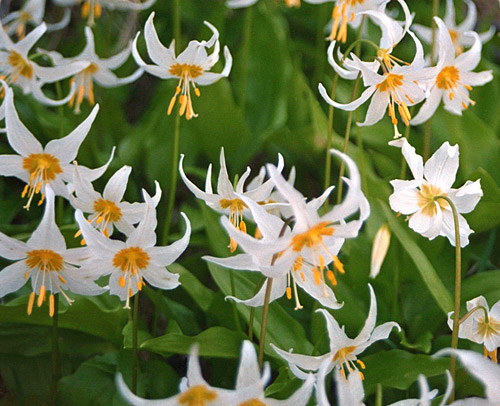|
|
|
|
|
|
|
|
|
|
|
|
|
|
|
|
|
|
|
|
|
|
|
|
|
|
|
|
|
|
|
|
|
Latin Name: |
Erythronium montanum |
|
|
Common Name(s): |
Avalanche Lily |
|
|
Family Name: |
Lily |
|
|
Size: |
6-16 inches |
|
|
Flower Size: |
1 1/2 to 2 1/2 inches wide |
|
|
Flower Shape: |
Bell Shaped, 3-6 Petaled |
|
|
Color(s): |
White ( |
|
|
Description: |
Nodding lilies with 6 curved, upsweeping tepals. Each flower is usually on top of a leafless, unbranched stem. The leaves are typically leathery, arising from the base of the stalk. Unlike its close cousin, the Glacier Lily, the Avalanche Lily has white flowers with yellow centers. Also, the Avalanche Lily has non-mottled leaves, unlike another close cousin, the White Fawn Lily. |
|
|
Tidbits: |
This flower is closely related to both the Glacier Lily and the White Fawn Lily, and its name is oftentimes used interchangeably with both. I like to make a distinction between the two, as the Avalanche Lily's beauty is an extra step above either of the other two. The Avalanche Lily is a distinct Northwest Cascades / Olympics flower. Its corms were a frequent source of food for the indigenous Northwest tribes. |
|
|
Ecology: |
Alpine and Sub Alpine, moist open areas (e.g. alpine meadows). Often found near melting snow |
|
|
Blooming Season: |
June-August (Elevation dependent) |
|
|
Related Flowers: |
Glacier Lily, White Fawn Lily |
|
|
Similar Flowers: |
Glacier Lily, White Fawn Lily, Tiger Lily, Queen's Cup |
|



 )
)

